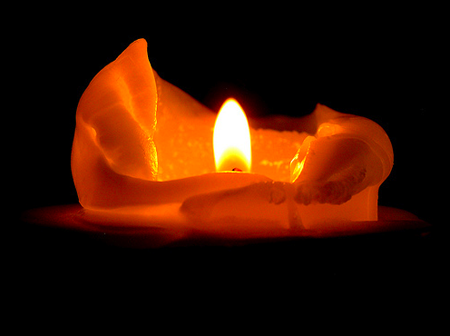Life Cycle is a series about the stories of our stuff.

It's been a long day. The wine has been uncorked. Now, a shoulder rub, perchance? With candles, please.
Candles are sort of deceptive, in environmental terms, because they seem so...well, good. The romance and old-timey feel of candlelight suggests virtue, and it beats electricity in an eco-battle, to be sure.
But we don't know many folks living by candlelight when the sun goes down. We do know many folks using candles to set the mood, the ambiance and even the Honey Mango Tea scent of their homes. Candles are big business, not as necessity but as decoration. Décor stores like Pier 1 devote entire walls to myriad scents, colors, shapes and textures of wax.
A few points to keep in mind when burning up the boudoir:
-Most candles are made from paraffin wax, which is derived from crude oil. Demand for these products plays into our reliance on fossil fuels.
-When burned, paraffin wax emits carbon. Yep, carbon emissions in your own home! A group of Israeli environmentalists even used candle-happy Hanukkah to highlight the carbon issue.
-The safety or potential toxicity of smells released as gases from fragranced candles is unknown. Anyone who got a headache from too much French Vanilla in 1996 can attest to the sketchiness of these potions.
-Older candles, the sort you've had in the Emergency Kit for twelve years, might have lead in their wicks. These babies are banned in many parts of the world, including the U.S. in recent years, but they slip into the market and wreak unhealthy havoc on indoor air quality.
Take heart, lovers--no need to put out the fire. Greener candle choices include those made with pure cotton or paper wicks (that means wire-free) and composed of soy or beeswax. While they send soot into the air, as any burning organic compound will, they rely on renewable resources and have a longer burn-life. Oh and, as always, the more local the better. Aussie Malcolm Tattersall summed it up well in a comment for New Scientist magazine:
Environmental friendliness is complicated and, in the end, relative. The total environmental cost of the candles that light a dinner table include production and transport costs, and the disposal or recycling costs of the remnants. The total environmental cost of the electric light they probably replace includes infrastructure costs. Both candles and electric light also cause pollution, the former in the dining room from burning wax and wick, and the latter from burning fossil fuel in the power station.
The "greenest" candles you could buy would be locally made from local beeswax, as they use renewable materials and incur little transport cost. Other than that, the fact that you are happy with the lesser light from candles instead of brighter electric light probably comes very close to balancing the higher environmental costs of candle production, plus their packaging and transport.
But if enjoyment of a candlelit dinner leads a couple to go to bed earlier than usual, they will have saved lighting and heating costs for the later part of that evening - which would surely outweigh the difference in environmental cost between candle and electric lighting over dinner. And if that should happen to lead, in turn, to two one-person households becoming one two-person household, with consequent long-term reductions in heating and lighting needs, I think we can say candles can indeed prove to be environmentally friendly as well as, er, friendly.
Bow-chicka-bow-wow.
This post was written by Simran Sethi and Sarah Smarsh. Thanks to the University of Kansas School of Journalism, Merete Mueller and Lacey Johnston for research assistance and KarenMarleneLarsen for the image.